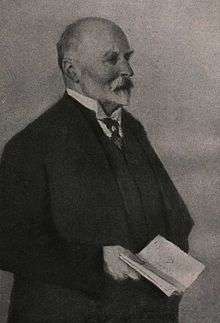Franz Boll (philologist)
Franz Boll (1 July 1867 – 3 July 1924) was a German scholar and contemporary of Cumont. He became Professor of Classical Philology at the University of Heidelberg.
Franz Boll (philologist) | |
|---|---|
 Franz Boll | |
| Born | July 1, 1867 |
| Died | July 3, 1924 (aged 57) |
He is known for his editorial and biographical work on Claudius Ptolemy. He also wrote on astrology. He is quoted as saying "Astrology wants to be religion and science at the same time; that marks its essence",[1] and "Mankind measures time using the stars. Lay people, whose knowledge is based on belief, rather than science, say: "The course of the stars determines Time," and from this, religious people drifts the saying that "Heaven guides everything on Earth."[2] Another quote of his is "Kronos and Helios were originally one and the same" [3]
Boll is also known for his claim that the Book of Revelation includes an allegorical depiction of the changes of astrological ages from the Age of Pisces to the Age of Aquarius where instead of the end of the world, the Apocalypse is really the end of an aeon.[4] He also wrote many astrological articles and with Gundel and Bezold produced one of the best introduction to the history of astrology.[5]
Works
- Studien über Claudius Ptolemaeus: Ein Beitrag zur Geschichte der griechischen Philosophie und Astrologie, in: Neue Jahrbücher für Philologie und Pädagogik, Supplementband 21,2 (1894), pp. 49–244.
- Sphaera: Neue griechische Texte und Untersuchungen zur Geschichte der Sternbilder (Leipzig: Teubner, 1903) – reprinted in 1967 by Georg Olms, Hildesheim.
- Erinnerungen an Ludwig Traube,[6] 1907
- Catalogus codicum astrologorum Graecorum: Band 7, Codices Germanicos descripsit Franciscus Boll (Brussels: Lamertin, 1908).
- [with August Kopff and Carl Bezold] Zenit- und Aequartorialgestirne am babylonischen Fixsternhimmel (1913).
- Aus der Offenbarung Johannis: Hellenistische Studien zum Weltbild der Apokalypse (Leipzig: Teubner, 1914) – reprinted in 1967 by Hakkert, Amsterdam.
- Antike Beobachtungen farbiger Sterne, (Munich: Akademie der Wissenschaften, 1916).
- [with Carl Bezold] Sternglaube und Sterndeutung: Die Geschichte und das Wesen der Astrologie (Leipzig: Teubner, 1917) – 7th ed. published in 1977 by Wissenschaftliche Buchgesellschaft, Darmstadt (also translated into Hungarian and into Italian).
- Kleine Schriften zur Sternkunde des Altertums (Leipzig: Koehler & Amelang, 1950) – edited by Viktor Stegemann.
Notes
- Astrology between religion and science (Abstract+Article) Archived 2007-01-09 at the Wayback Machine at www.rudolfhsmit.nl
- Editorial 2002 at www.paleolithicartmagazine.org
- Franz Boll – Kronos-Helios, Archiv für Religionswissenschaft XIX (1919), p. 344.
- Anna-Teresa Tymieniecka, "Astronomy and Civilization In the New Enlightenment: Passions of the Skies", Springer, 2011, p 95
- Lester Ness, "Historians of Astrology ", http://cura.free.fr/xxv/25ness.html%5B%5D
- That is Ludwig Traube (palaeographer)
External links
- Historians of Astrology - by Lester Ness (Changchun University of Technology) at cura.free.fr
- Some Modern Historians of Ancient Occidental Astral Sciences at members.optusnet.com.au
- History of Constellation and Star Names at members.optusnet.com.au